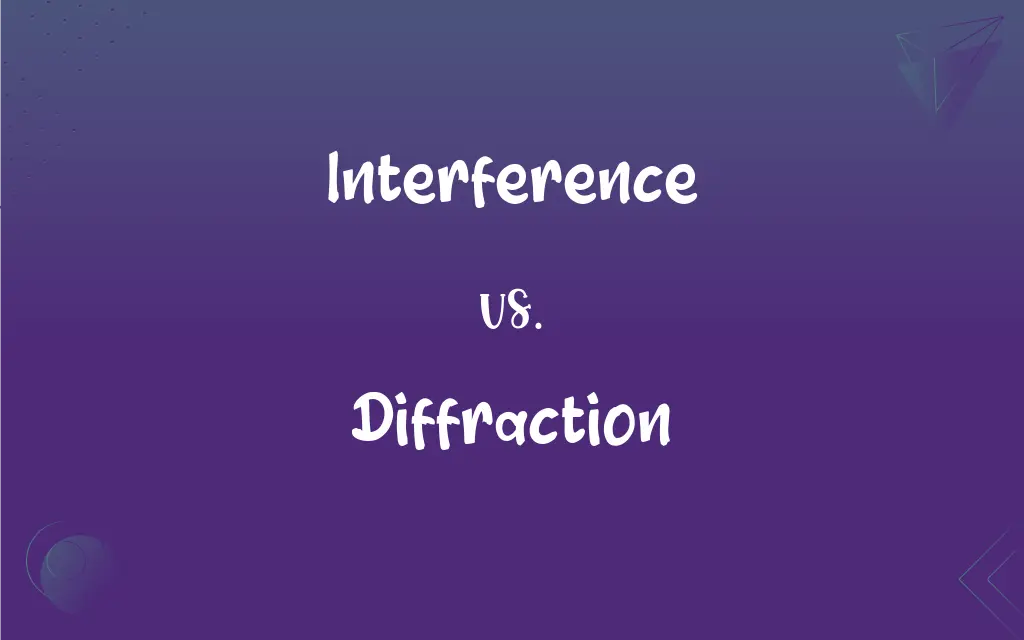Interference vs. Diffraction: What's the Difference?
Edited by Harlon Moss || By Janet White || Published on March 1, 2024
Interference is the combination of two or more waves resulting in a new wave pattern, while diffraction is the bending and spreading of waves around obstacles and openings.

Key Differences
Interference occurs when waves, typically of the same frequency, overlap and combine, creating a pattern of alternation between constructive and destructive interference. Diffraction involves the bending and spreading of waves, especially when they encounter obstacles or pass through narrow openings.
In interference, the resulting pattern is a series of alternating high and low-intensity regions due to the superposition of wave amplitudes. In diffraction, the wave spreads out, creating a pattern that demonstrates the wave's ability to bend around obstacles and through openings.
Interference is most pronounced when the waves are coherent and of similar wavelengths. Diffraction, on the other hand, becomes more noticeable when the size of the obstacle or opening is comparable to the wavelength of the wave.
Interference is used in applications like interferometry to measure small distances or changes in distance. Diffraction is exploited in techniques like X-ray crystallography to determine the structure of crystals.
Interference can be observed in phenomena like the colorful patterns in soap bubbles or oil films. Diffraction is visible in everyday examples like the spreading of light when it passes through a narrow slit or the pattern seen when light passes through a fine fabric.
ADVERTISEMENT
Comparison Chart
Definition
Overlap of waves creating a new pattern
Bending and spreading of waves
Resulting Pattern
Alternating regions of intensity
Wave spreading and bending
Required Conditions
Coherent waves of similar wavelengths
Obstacle or opening near wave's size
Scientific Applications
Interferometry, thin-film analysis
X-ray crystallography, gratings
Everyday Observations
Soap bubbles, thin film interference
Light through slits, diffraction gratings
ADVERTISEMENT
Interference and Diffraction Definitions
Interference
Can be constructive (amplitude increases) or destructive (amplitude decreases).
Constructive interference amplified the sound at the concert hall's center.
Diffraction
A fundamental behavior observed in all types of waves, including light and sound.
Water waves diffracting around a pier created an intricate wave pattern.
Interference
Often observed in waves of the same frequency and phase.
Laser beams often create visible interference patterns due to their coherence.
Diffraction
Occurs when a wave encounters an obstacle or opening comparable to its wavelength.
Sound diffraction was evident when the music was audible around a corner.
Interference
The combination of two or more waveforms to form a composite wave.
The interference pattern in the soap bubble showed bright and dark fringes.
Diffraction
The bending of waves around the edges of an obstacle or aperture.
Diffraction caused the light to spread as it passed through the narrow slit.
Interference
A phenomenon where waves superimpose to form a resultant wave.
Sound interference in the room created areas of loud and soft sounds.
Diffraction
Leads to the formation of patterns such as fringes and bands.
The diffraction grating created a spectrum of colors from white light.
Interference
Used in various scientific applications for precise measurements.
Optical interferometry relies on light interference for accurate measurements.
Diffraction
Used in scientific methods like X-ray crystallography.
X-ray diffraction helped in determining the crystal structure of the mineral.
Interference
The act or an instance of hindering, obstructing, or impeding.
Diffraction
Change or dispersion of the direction and intensity of a wave as it traverses an object or aperture, especially when the size of the object or aperture approximates the wavelength of the wave.
Diffraction
(physics) The bending of a wave around an obstacle.
Diffraction
(quantum mechanics) The breaking up of an electromagnetic wave as it passes a geometric structure (e.g. a slit), followed by reconstruction of the wave by interference.
Diffraction
The deflection and decomposition of light in passing by the edges of opaque bodies or through narrow slits, causing the appearance of parallel bands or fringes of prismatic colors, as by the action of a grating of fine lines or bars.
Remarked by Grimaldi (1665), and referred by him to a property of light which he called diffraction.
Diffraction
When light passes sharp edges or goes through narrow slits the rays are deflected and produce fringes of light and dark bands
FAQs
What causes interference?
Interference is caused by the superposition of two or more coherent waves.
What is an example of diffraction in nature?
An example is the spreading of light waves around the edges of an object.
Can diffraction occur with sound waves?
Yes, diffraction occurs with all wave types, including sound waves.
Can interference occur with light waves?
Yes, interference commonly occurs with coherent light waves.
Is interference visible in everyday life?
Yes, interference can be seen in phenomena like oil film patterns on water.
How does wavelength affect interference?
Wavelength affects the spacing and intensity of interference fringes.
Are interference patterns always colorful?
Not always; color depends on the light's wavelength and the interfering medium.
Can diffraction patterns be used in scientific analysis?
Yes, diffraction is used in methods like X-ray crystallography for analyzing structures.
Can diffraction be observed with a single slit?
Yes, single-slit diffraction results in a characteristic pattern of light and dark bands.
What factors influence sound wave interference?
Factors include the frequency, phase difference, and path length of the sound waves.
What is a common example of diffraction in technology?
Diffraction gratings used in spectrometers are a common technological application.
What is the principle behind holography?
Holography is based on recording and reconstructing light wave interference patterns.
Is diffraction a limitation in optical systems?
Yes, it can limit the resolution of optical systems like telescopes and microscopes.
How does diffraction affect sound?
Diffraction allows sound to bend around obstacles and be heard even when the source is not directly visible.
Can interference be used to measure distances?
Yes, techniques like interferometry use interference patterns to measure distances precisely.
Is interference only observed with light?
No, interference can occur with any type of wave, including sound and water waves.
Does the size of an aperture affect diffraction?
Yes, the size relative to the wave's wavelength significantly affects diffraction patterns.
Can interference be destructive?
Yes, when waves are out of phase, they can interfere destructively, reducing amplitude.
Is the interference pattern the same for all wave types?
The basic principles are similar, but the pattern details depend on the type of wave and its properties.
How does diffraction limit telescope resolution?
Diffraction causes light to spread, blurring the image and limiting the telescope's ability to resolve fine details.
About Author
Written by
Janet WhiteJanet White has been an esteemed writer and blogger for Difference Wiki. Holding a Master's degree in Science and Medical Journalism from the prestigious Boston University, she has consistently demonstrated her expertise and passion for her field. When she's not immersed in her work, Janet relishes her time exercising, delving into a good book, and cherishing moments with friends and family.
Edited by
Harlon MossHarlon is a seasoned quality moderator and accomplished content writer for Difference Wiki. An alumnus of the prestigious University of California, he earned his degree in Computer Science. Leveraging his academic background, Harlon brings a meticulous and informed perspective to his work, ensuring content accuracy and excellence.































































